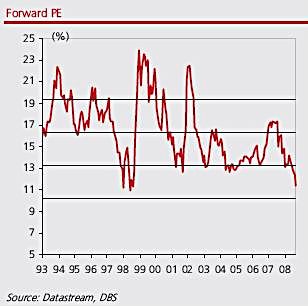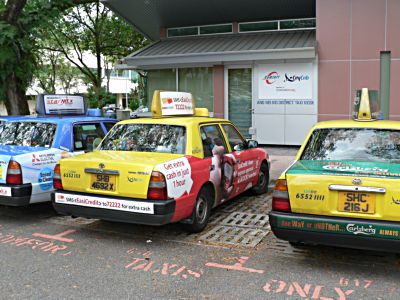
DBS Vickers’ “Regional Equity Strategy 1Q 2009” report was titled Fire Sale.
It said the Singapore market is oversold, and poised for a rebound on cheap valuations.
But uncertainties continue to lurk amidst a tough operating environment, as recession hits and job cuts continue to rise.
“The bears will prevail in 2009, and we expect the STI to trade within a band of 1250 to 2100 as it base-builds towards a more convincing recovery in 2010.”
Excerpts from the report:

Post the meltdown in October 2008, the market is cheap by all measures. At current levels of 1740, forward PE of 11x is close to the regional crisis low and dividend yields of 5.2% has surpassed previous lows of 3.5%. An expansionary budget to be unveiled inJanuary 2009, coupled with optimism over Obama’s fiscal measures to boost theUS economy are key catalysts for the rebound in 1Q09.
The economy is not out of the woods yet, and bad news from the corporate sector will cap performance. We expect the STI to trade within a range of 1450 to 2180. The low end of the range reflects a P/B of 0.9x, which is -2 standard deviations from the mean.
This is consistent with recession year valuations.
Stick to survivors of the fittest with the tenacity to ride through this recession.These will be companies backed by relatively resilient earnings, strong cashflows, and cashed-up balance sheet. They are in a favourable position to acquire cheap assets as deflation runs its course into 2009. Our preferred picks are SMRT, SIA Engineering, SPH and ST Engineering.
We would sell asset plays including property and shipping companies on the rebound, as the process of de-leveraging will lead to asset devaluation in 2009. Distressed valuation levels will spur M&A activities, potential candidates can be found among technology,oil and gas and S chips.
STRATEGY
Themes :

Photo by NextInsight
A) Go for stocks with earnings resilience in recessions.
We would pick stocks with earnings resilience, as the economy struggles through the recession.
As we are still in the early phase of the recessionary cycle, we would pick stocks with resilient earnings – mainly land transport companies, media services and telecoms companies.
Our preferred picks are SMRT and Comfort Delgro, beneficiaries of the switch to public transport, as evidenced by a rise in ridership, while M1 is the cheapest telco play.
Singpost’s revenues were maintained during previous recessions (1998 and 2003) while SPH is the monopolistic player in newspaper advertising in Singapore.
B) Sell asset plays on strength.
The process of de-leveraging has yet to complete its course, and asset deflation has just started to unwind. We would take the opportunity in a bear market rally to sell on strength stocks in the property, shipping and hotel sectors.
Property stocks have been sold down to distressed levels, trading at prices close to its 1998 valuation levels, hovering at price to RNAV of 0.5x. The sector, while cheap, provides no catalyst for re-rating as yet, as we expect more downside to prices of properties.
Anecdotal evidence indicated that prices for high end properties have declined by 20% from its peak, vs our expectations of a 40% decline. Shipping stocks are hit by a plunge in freight rates, overcapacity issues and aggressive expansion plans which will stress their balance sheets.
Hotel plays are capped by drops in tourist arrivals since June 2008, amidst new capacity coming on-stream from 2009 once Marina Sands is completed by end-09.
C) Survival of the fittest – stress testing the balance sheet.
Contrary to market perception, net debt to equity ratio of STI companies at 23% currently is higher than the regional crisis levels of 1997 to 1999. In early 2000, companies, particularly Temasek-linked entities, were shifting towards optimizing their capital structure and efficient capital management, leading to higher dividend payouts.
As such, net debt ratios shot up to 50% in 2002, in tandem with arise in dividend payout ratio to 80% and a fall in corporate earnings. Subsequent years of economic boom led to a period of build up in cash flows, and decline in net debt.







